Beyond the populism of vegan superfoods, plastics alternatives and climate solutions, there is gathering research interest and financial support for seaweeds which could underpin a new plant-focused approach to aquaculture in Australia
By Catherine Norwood
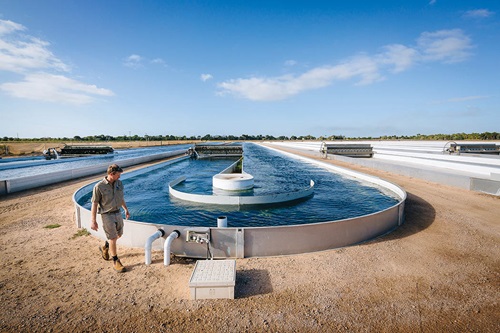 Pacific Bio’s production manager – macro algae, Chris Praeger, monitors raceways where sea lettuce is being used to treat water from prawn ponds.
Pacific Bio’s production manager – macro algae, Chris Praeger, monitors raceways where sea lettuce is being used to treat water from prawn ponds. Photo: Andrew Rankin
In Australia, seaweed aquaculture is a nascent industry, although one for which momentum is growing, with new research into native species, propagation techniques and functional properties. Long-term ambitions are large and growing. There is the potential for a billion-dollar industry providing thousands of jobs – many in regional communities – and a range of increasingly important ecosystem services along with new food and industrial products.
Global impacts
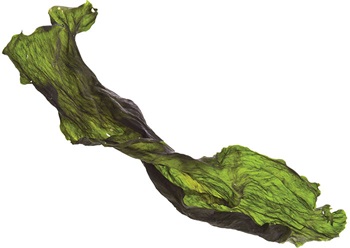 Photo: Shutterstock
Photo: Shutterstock
Figures from the United Nations Food and Agriculture Organization (FAO) indicate that cultivated seaweed production in 2015 amounted to 30 million tonnes globally. This was led by China (13.9 million tonnes), Indonesia (11.3 million tonnes), the Philippines (1.5 million tonnes) and South Korea (1.2 million tonnes).
China currently has more than 1250 square kilometres of farmed seaweeds that are grown for the products they provide, including foods and industrial food and chemical ingredients, but just as important is their ability to improve water quality in areas affected by high nutrient and low oxygen levels, and increased acidity. One recent research project estimated that China’s farmed seaweeds remove 75,000 tonnes of nitrogen and 9500 tonnes of phosphorus from the country’s coastal waters each year.
The ability of seaweeds to help mitigate climate change by absorbing carbon is gaining considerable attention and is the focus of many new research projects. Leading Australian scientist and conservationist Tim Flannery is an advocate of seaweeds and what they can deliver for humans and the environment. In his 2017 book Sunlight and seaweed − an argument for how to feed, power and clean up the world he outlines how large-scale seaweed cultivation could reduce levels of atmospheric carbon to fix current climate issues.
To sequester carbon requires growing it (capturing the carbon), then harvesting the seaweed or allowing it to sink and accumulate on the ocean floor (locking it up), effectively burying stored carbon. While it is known that carbon captured by seaweeds can be sequestered in oceanic sinks, there are still unknowns in the sequestration process, in particular what happens to the seaweed when it sinks. Continued research to answer key questions will be needed if seaweed is to establish its carbon-accounting credentials, allowing for the creation of blue carbon offsets.
Tackling methane
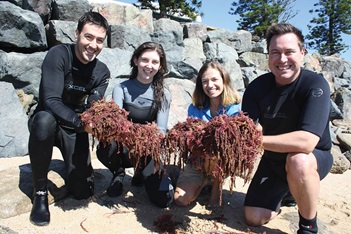 The seaweed team. Photo: USC
The seaweed team. Photo: USC
There are many seaweeds with existing markets and cultivation practices in other countries that are also native to Australia, such as Giant Kelp (Macrocystis species) and various species of Gracilaria. But Australia also has hundreds of unique species that may yet yield novel and highly valuable properties.
At the CSIRO, livestock systems scientist Rob Kinley and his team have identified the species properties of the native Asparagopsis, a red seaweed which contains chemicals that inhibit fermentation within the gut of cattle. When fed as a supplement to cattle it can reduce their methane emissions by 90 per cent or more.
In greenhouse gas terms, methane (CH4) is 28 times more detrimental than carbon dioxide (CO2) and emissions from livestock account for up to 12 per cent of Australia’s total greenhouse gas emissions (and up to 50 per cent in New Zealand). These emissions also represent lost energy from feed of between two and 10 per cent. So as well as greatly reducing methane emissions, the use of Asparagopsis supplements within cattle feeds could also improve farm productivity.
While there is currently no commercial production of Asparagopsis in Australia, the CSIRO, Meat & Livestock Australia and James Cook University have jointly patented its use as a feed supplement, which they are commercialising as FutureFeed™, for ruminant livestock such as cattle and sheep.
Scale of production
Rob Kinley says he is now researching the minimum amount of seaweed needed in livestock diets to eliminate methane emissions. As a starting point, based on supplements for 10 per cent of the national dairy herd and feedlot cattle, he estimates 85,000 tonnes of Asparagopsis (wet weight) a year would be needed, requiring about 425 hectares of seaweed farms.
To meet this need, a number of commercial companies, some in collaborations with research organisations, have recently begun to explore the culture of this species onshore and in-sea in Australia, as well as overseas. One of these is CH4 Global, a team of international innovation and investment experts committed to developing sustainable Asparagopsis production to address climate change.
In South Australia, general manager of aquaculture for Primary Industries and Regions South Australia (PIRSA), Adam Main, says the state is in discussions with CH4 at a government level to identify potential sites to farm the species. He says 70 hectares will initially be made available for trials, with 1000 hectares or more zoned for seaweed in the longer term. While Port Lincoln is an area of primary interest, PIRSA is also working with the Narungga Nation Aboriginal Corporation on the Yorke Peninsula about its possible involvement in seaweed initiatives.
Previous research by the South Australian Research and Development Institute has already identified several other species with potential for cultivation, some possibly as part of multi-trophic aquaculture with finned fish culture. Adam Main says further work will be done to progress these species too.
In Adelaide, Flinders University is also leading a bid to establish a Marine Bio-products and Biotechnology Cooperative Research Centre (CRC). This CRC would focus on identifying and developing bioproducts from marine resources such as microalgae and macroalgae, for uses including human functional foods, and nutrition and animal feeds. It intends to address the whole production chain, including production, processing and product aspects.
Land-based farming
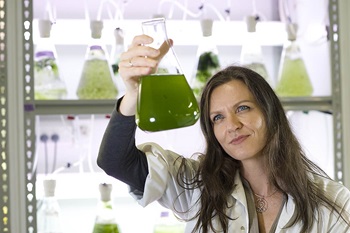 Pia Winberg, who established land-based production of seaweed in the NSW Shoalhaven in 2014.
Pia Winberg, who established land-based production of seaweed in the NSW Shoalhaven in 2014. Photo: Blue BioTech Shoalhaven
It is human, rather than animal health, that has been the focus of seaweed aquaculture from one of Australia’s pioneers in this space, Pia Winberg, who established land-based production of species of sea lettuce, Ulva, in the NSW Shoalhaven in 2014. Pia Winberg’s company, Venus Shell Systems, has a strong research and development focus, which builds on her previous research, including a report for AgriFutures on cultivating Australian seaweeds for health and nutritional markets. Tapping into the strong consumer trends in nutrition and gut health, her business is expanding quickly, with increased processing and farming capacity.
A seaweed pasta is part of her PhycoPRO™ branded foods and supplements range of seaweed products for food, digestive and skin health applications. It’s entirely feasible, Pia Winberg says, that 10 per cent of the wheat flour used to make pasta in Australia could be replaced with seaweed, increasing the nutritional benefits of the product.
This year her business Venus Shell Systems will produce 40 tonnes, which equates to four tonnes of dried seaweed. Small beginnings, but Pia Winberg has much bigger goals. By 2021 she expects to grow 100 tonnes of seaweed, using a series of raised ponds across one hectare of the current site. With five hectares at this location, the business has the potential to produce up to 500 tonnes of seaweed a year in the Shoalhaven, and is also investigating five new sites around the country.
Multi-trophic aquaculture
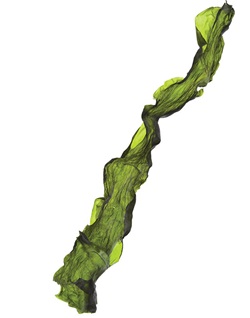
Since 2016, Tasmanian Atlantic Salmon producer Tassal has been investigating ocean-based, integrated, multi-trophic aquaculture – a combination of fish, shellfish and seaweed that some call 3D mariculture. The research initially included Camerons Shellfish and Seaweeds Tasmania, but from late 2017 it continued in conjunction with Spring Bay Seafoods, the Institute for Marine and Antarctic Studies (IMAS) at the University of Tasmania and Deakin University, with FRDC funding.
These parties secured a CRC project grant this year to scale up the work over the next three years, with $5.5 million combined funding from the grant and all participants. Hatchery and grow-out methodologies have been developed for local kelp species with the aim of initiating a seaweed-based industry that will generate environmental benefits.
Australia also has its own philanthropic, climate-driven seaweed initiative underway in Storm Bay, in southern Tasmania. Partly crowd funded, the project is a collaboration involving the producers of the climate change movie 2040, the Climate Foundation, University of Tasmania and The Intrepid Foundation.
The project raised $350,000 earlier in 2019 for research into the propagation of native Giant Kelps.
These species, which once formed extensive underwater forests along Tasmania’s eastern coastline, have largely disappeared during the past decade as a result of warm water from the East Australian Current extending further and further south. In phase two of the project, another $250,000 is being raised to establish an offshore pilot platform in Storm Bay to regrow these kelps. Huon Aquaculture is also collaborating with the Climate Foundation and Giant Kelp trials, helping Tasmanian researcher Cayne Layton from IMAS with planting of kelp seedlings at its two lease sites in Storm Bay in October.
Water quality
Queensland initiatives include the use of the sea lettuce Ulva ohnoi as part of water remediation processes at Pacific Bio’s prawn farm in Ayr. The seaweed draws on the nutrients in the discharged prawn pond water for its own growth, which results in lower nutrient emissions in the water.
This process has been developed in conjunction with James Cook University. Pilot trials at Ayr provided crucial proof-of-concept for zero net nutrient emissions in the treated water, paving the way for the approval of new prawn ponds at the company’s Guthalungra site further south, adjacent to the Great Barrier Reef.
James Cook University professor and chief technical officer for Pacific Bio, Rocky de Nys, has been closely involved in the project development and says that even prior to the Guthalungra expansion being completed, seaweed production at Ayr has been so successful that Pacific Bio is already expanding production.
It will increase the seaweed production area from 0.5 hectares to 2.5 hectares within the year, with seaweed yields increasing from 200 tonnes in 2019 to more than 1000 tonnes by 2022. He says the seaweed is in demand as the ingredient for PlantJuice™, developed by Pacific Bio, a high-performing plant biostimulant used predominantly by local sugar cane farmers. The seaweed is also being used in aquaculture feeds.
Options to diversify
.jpg?h=234&w=351&la=en&hash=B6C2A01957C9C6C91C97E1A46E128B19712F24A9) A puffy pink seaweed that can stop cows from burping out methane is being primed for mass farming by University of the Sunshine Coast researchers. The University’s Seaweed Research Group leader Associate Professor Nick Paul says that if Australia could grow enough of the seaweed for every cow in Australia, the country could cut its greenhouse gas emissions by 10 per cent.
A puffy pink seaweed that can stop cows from burping out methane is being primed for mass farming by University of the Sunshine Coast researchers. The University’s Seaweed Research Group leader Associate Professor Nick Paul says that if Australia could grow enough of the seaweed for every cow in Australia, the country could cut its greenhouse gas emissions by 10 per cent. Photo: USC
Further south in Queensland, Sandy and Wade McFadgen at Moreton Bay Rock Oysters have secured a variation to their 48 hectare oyster lease in the Moreton Bay Marine Park to farm any of the 20 or so seaweeds native to the local area. Wade McFadgen says they will be providing a test case for production in the bay, as part of an FRDC-funded research project.
Wade McFadgen believes seaweeds offer an opportunity for local oyster producers in the bay to diversify production and generate new income. “We’ll need research and development into possible uses, whether that’s for food or pharmaceuticals, or something else. To make it successful we’ll also need volume and markets, and that may take a while to develop.”
Trials will kick off in 2020 to identify the best-performing seaweeds at the location and any potential ramifications from farming. Leading candidates for production include edible seaweeds such as sea lettuce, red seaweeds for agar-agar and carrageenan gels, and brown seaweeds for health applications.
Nick Paul and Alexandra Campbell at the University of the Sunshine Coast (USC) are working closely with the McFadgens in their initial trials, and will also help assess the potential of seaweeds to offset nutrients washed into the bay.
The research team is developing propagation techniques for sea-based culture for a range of species, including Asparagopsis, and will document the environmental benefits of seaweed farming.
Nick Paul has also worked extensively in Indonesia, where he says production ranges in scale from smallholder farming families to huge industrial operations. In Australia, he believes combining production with existing aquaculture enterprises makes sense as a way to help establish a local industry.
The Australian Seaweed Institute (ASI) also has a development proposal underway for Moreton Bay, with a larger vision for 60 hectares of seaweed mariculture, producing up to 5000 wet tonnes a year. CEO Jo Kelly is enthusiastic about the potential for a national seaweed industry to provide jobs in regional areas, while the crop itself provides ecosystems services that support a low carbon economy.
She says the Queensland Government is supportive of seaweed aquaculture. “It’s a no-brainer to invest in an industry that improves the health of bays, oceans and reefs, provides jobs in regional areas and produces high-value products for the domestic and international markets. The time is right to bring regulators, researchers and industry players together to get serious about mobilising investment needed to grow seaweed to a billion-dollar industry.”
In an independent initiative in Western Australia, Ashley Sutton has been conducting trials at the Abrolhos Islands for the past year, selecting three of the initial seven species trialled for further development.
For Ashley Sutton, a former interior designer for hotels and hospitality venues in Asia, the move to seaweed farming represents a return to his roots − he grew up in Fremantle and has family members in the commercial fishing sector. But it is also a move with the future in mind, given the many benefits and diverse markets for seaweed products.
He has a 10-hectare marine lease at the Abrolhos Islands and hopes to begin commercial production within the next 12 months. He says the final decision on which species to grow and target markets will depend on which of the three shows the best growth rates during the next six months.
A seaweed primer
Seaweed is part of the algae family, which is found around the world in many thousands of forms, ranging from microscopic species to giant underwater forests towering five storeys above the ocean floor.
Algae is the general term applied to types of aquatic plants, although they aren’t really plants in a botanical sense, in that they don’t have roots and leaves and other plant features; their cell structure is comparatively simple. Algae is found in oceans, rivers, lakes and other water bodies. Most forms use photosynthesis to convert energy from sunlight in order to grow, as land-based plants do, although some can grow in the dark using sugar or starch for energy.
The microalgae members of the family are single-cell organisms, the largest of which might be 0.5 millimetres. There are green, brown and red microalgae species, as well as cyanobacteria, which is similar to bacteria, commonly known as ‘blue-green algae’.
Seaweed is a common term for macroalgae, the larger members of the algae family. There are three main types of seaweed: green, red and brown. Australia has thousands of different species. Of the 1000 kinds identified in southern Australia, about 60 per cent are endemic, found only in this part of the world.
Kelps (Laminariales) are a particular group of large brown seaweeds. Giant Kelp (Macrocystis sp.) can grow into substantial underwater forests up to 20 metres high, such as those found off the eastern coast of Tasmania. During the past decade the Tasmanian kelp forests have largely disappeared as a result of warm water from the East Australian Current moving further south along the Tasmanian coastline.
Australian species
Widely recognised species native to Australia include:
Brown:
- common or golden kelp (Ecklonia radiata)
- lobster or crayweed (Phyllospora comosa)
- Neptune’s necklace (Hormosira banksii)
Green:
- sea lettuce or greenweed (Ulva sp.)
- seagrapes (Caulerpa sp.)
Red:
- Nori (Porphyra or Pyropia spp.)
Exotic seaweeds
Among the most widely known exotic species is Wakame (Undaria pinnatifida), which has been found in Victorian and Tasmania waters. It has been declared an invasive species in these states.
Seagrasses
Seagrasses are aquatic flowering plants that have roots and leaves. They have a vascular system – specific plant tissues responsible for the distribution of nutrients – unlike seaweeds, which have a holdfast that connects them to the ocean floor and which distributes nutrients by diffusion.
The Marine Education Society of Australasia has detailed 33 species of seagrass found in Australia, including short eelgrass (Zostera muelleri), ribbonweed (Zostera capricorni), sea nymph (Amphibolis antarctica) and paddleweed (Halophila australis). It estimates that there are 51,000 square kilometres of seagrass meadows in intertidal environments.
The new Australian Standard for Aquatic Plant Names in development is designed to support a new seaweed production industry by providing all parties to the seaweed production and supply chain with an agreed, common language when discussing and marketing different species.
More information
Marine plants of Australia
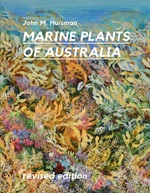
With a growing interest in seaweeds and potential applications in food, industrial and environmental systems, the December 2019 release of the latest edition of Marine plants of Australia is timely. It is the work of one of Australia’s leading seaweed taxonomists, John Huisman.
This second edition illustrates over 600 species of Australia’s underwater plant life, mostly with underwater photographs that reveal the amazing colours and intricate patterns found in this largely unknown realm of life.
There are seaweeds with the consistency of jelly, or with fronds that form an intricate mesh that rivals the best lace. These plants have evolved into a myriad of startling shapes, colours and patterns that will impress everyone who views them − underwater, or through the pages of this book.





